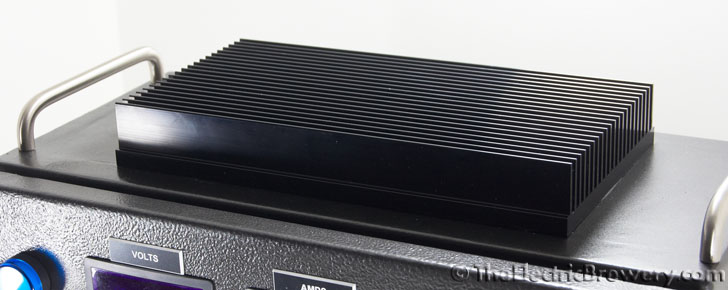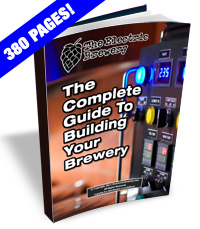Control Panel (Part 1)
STEP 3: Choose heat sink(s)
 Large black anodized heat sinks are nearly impossible to find at reasonable prices. To make life easier for those who wish to build their own control panel, we've partnered with a manufacturer to purchase large aluminum heat sinks in volume and then professionally anodize them in batches to reduce the cost. It is also included in our control panel kits. For complete details see our Products page.
Large black anodized heat sinks are nearly impossible to find at reasonable prices. To make life easier for those who wish to build their own control panel, we've partnered with a manufacturer to purchase large aluminum heat sinks in volume and then professionally anodize them in batches to reduce the cost. It is also included in our control panel kits. For complete details see our Products page.
The size and position of the holes you create on the top of the control panel depend on the heat sink(s) you use. We need to make that choice now before continuing.
Inside the control panel are two SSRs (solid state relays) that are used to turn the heating elements on and off. An SSR creates a lot of heat and requires a heat sink to dissipate this heat otherwise it will overheat and burn out quickly.
SSRs are sold by the amperage that they are able to switch. Popular sizes include 10, 25, 40, 80, and 100 amps. Heat sinks are often sold bundled with SSRs to match their size. The more current that is switched, the larger the heat sink required.
Our 5500W elements consume approximately 23 amps of current when in use, requiring at least a 25 amp SSR. This is, however, very close the maximum rating of the SSR so we chose instead to use a 40 amp SSR and run it at around half the rated capacity. Like most electronic and mechanical devices, an SSR will last longer if it's not driven to the top end of its rated capacity.
 Using a heat sink that is typically sold with a 40 amp SSR should be more than adequate since we are only switching 23 amps. The heat sink will provide better cooling to offset situations like poor air flow or warm ambient temperatures since it is oversized.
Using a heat sink that is typically sold with a 40 amp SSR should be more than adequate since we are only switching 23 amps. The heat sink will provide better cooling to offset situations like poor air flow or warm ambient temperatures since it is oversized.
Of course, if a 40 amp heat sink cools better than a 25 amp, why not go even larger? The larger the heat sink, the better the cooling and the less stress on the SSRs. After many months of searching we found an even larger used heat sink for sale on eBay so we use it to cool both SSRs instead. It does not even get warm to the touch.
Our heat sink is 12" wide, 7" deep, and 3" high. It is most certainly overkill for this situation. Assuming the fin density between the standard 40 amp heat sink and our 'overkill' heat sink are the same, ours is 4.2 times larger (252 cubic inches versus 2 x 30 cubic inches).
If you decide to source your own large heat sink, keep it between 8-13" long and 4-7" deep. Anything larger will not fit properly on top of the enclosure and leave enough room to use the carrying handles. Height is not overly important. Any heat sink this large over 1-2" high will certainly cool adequately. An anodized aluminum heat sink will cool better than a non-anodized (silver) heat sink. (More information)
Using two standard 40 amp heat sinks meant for 40A SSRs is certainly more than adequate but they may be harder to mount outside the enclosure as many present a surface area only large enough for the SSR, leaving no room for mounting to the enclosure. If you'd like to use a larger heat sink as we did, by all means go for it but do not feel it's a requirement. We just preferred the increased cooling ability and the look of one large heat sink compared to two smaller ones.
Our 'overkill' heat sink (for two SSRs) next to a standard 40 amp heat sink (meant for a single SSR):
The 10" x 5.375" x 1.375" custom heat sink sold through our products page is perfectly suited for our control panel.
The low profile means that the fins are exactly the same height as the handles we will be installing later. A perfect match!






